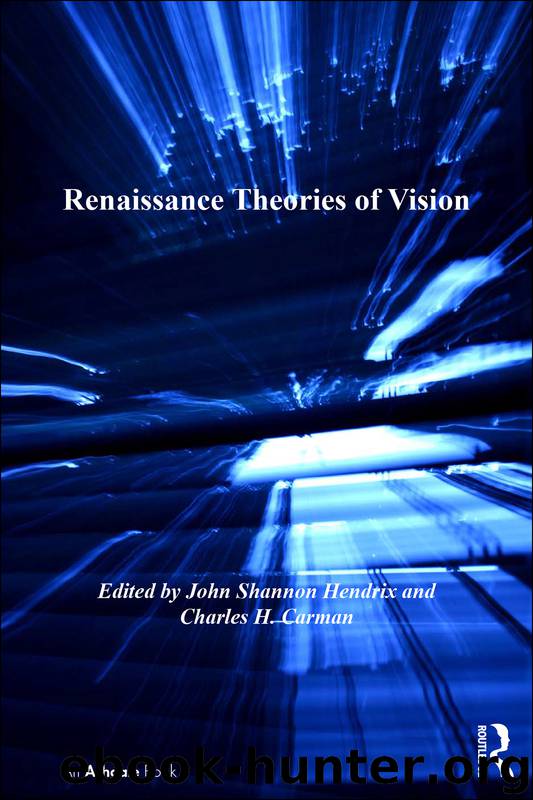Renaissance Theories of Vision by Hendrix John Shannon; Carman Charles H.; & Charles H. Carman

Author:Hendrix, John Shannon; Carman, Charles H.; & Charles H. Carman
Language: eng
Format: epub
Publisher: Routledge
Published: 2012-03-14T16:00:00+00:00
12 Raphael, Madonna di Foligno (detail), c. 1512, Vatican Museums, Rome. Photo credit: Scala/Art Resource, NY
In keeping with their ancient models, many Renaissance putti cultivated playful demeanors appropriate to their youthful forms, throwing flowers, making music, dancing, and hoisting garlands.3 Others appear in attitudes of deep veneration, paying homage, as the multitudinous inhabitants of heaven, to God, the saints, or the Virgin.4 In those cases where they represent angels, the putto’s job was one of ministration, aiding in the revelation of the godhead to men.
There was, however, a problem in adapting the classical putto to Christian ends. While in antiquity the invisible or spiritual nature of putti was not generally emphasized, the Renaissance putto could be an angel who was by definition bodiless, lacking physical, fleshly form.5 When angelic putti appeared to humans, they had to do so by means of a physical illusion, for otherwise they would be invisible to the corporeal eyes of men. The problem for artists was further compounded, however, by the fact that classical putti, known primarily from ancient statuary, were first introduced to Renaissance art in bronze and marble.6 Although a sculptor might attempt to “dematerialize” the putto using low relief and schiaciatto, the true nature of angelic putti could be more effectively conjured through pictorial means.7
It appears that it was a theological impulse that caused Quattrocento painters, after having adopted the angelic putto, to develop a number of related conventions. Representing angelic immateriality as transparency, some artists chose to designate putti by their mere outlines drawn against the light of a glory, as in the case of Luca Signorelli’s putti in the cupola of the Sacristy of San Giovanni at the Basilica of the Santa Casa at Loreto (c. 1478). A related approach was to depict putti monochromatically in a single modulated color such as gold, red, or blue, which associated the putto with supernatural attributes like aureoles. Notable examples of monochromatic putti can be found in Andrea Mantegna’s Friedsam Madonna (c. 1460), where gold and red putti crowd around the Virgin and Child in the form of an angelic mandorla.
While the “transparent” and “monochromatic” putti of the Quattrocento can be understood as responses to a basic theological dilemma, they did not, in fact, answer to it entirely. While, for some artists and viewers, the fleshly putto did not adequately signal the immateriality of angelic beings, the solutions for representing that immateriality could not avoid the charge that they still offered embodiment by different means. Transparent and monochromatic putti pointed to the spiritual nature of angels, but they could not explain away their vestigial visibility. These kinds of putti were, in essence, iconographic compromises, for ultimately the outlines of even “transparent” putti are visible to the bodily eyes.
The twin problems of immateriality and visibility thus led in two different directions. One viewer might prefer the fleshly putto because it acknowledged that angels assume physical bodies or on account of its classical pedigree; another might prefer putti that acknowledge their essential immateriality. The choice
Download
This site does not store any files on its server. We only index and link to content provided by other sites. Please contact the content providers to delete copyright contents if any and email us, we'll remove relevant links or contents immediately.
Ancient Worlds by Michael Scott(2622)
Savage Harvest by Carl Hoffman(1913)
The Monuments Men by Robert M. Edsel(1738)
Cain by Jose Saramago(1493)
The Apogee - Byzantium 02 by John Julius Norwich(1410)
A History of the World in 100 Objects by MacGregor Neil(1311)
The O. Henry Prize Stories 2014 by Laura Furman(1208)
The Unfinished Palazzo by Judith Mackrell(1141)
The Swerve by Greenblatt Stephen(1120)
The Lost Secrets of Maya Technology by James A. O'Kon(1089)
50 Art Ideas You Really Need to Know by Susie Hodge(1053)
Joan Miró by Joan Miró(1029)
4 3 2 1 by Paul Auster(1023)
Cain by Saramago José(1016)
A Piece of the World by Christina Baker Kline(994)
Heretics and Heroes by Thomas Cahill(984)
The Book of Ruby(966)
Raising Hell: A Concise History of the Black Arts and Those Who Dared to Practice Them by Robert Masello(951)
1484244826 by Unknown(900)
